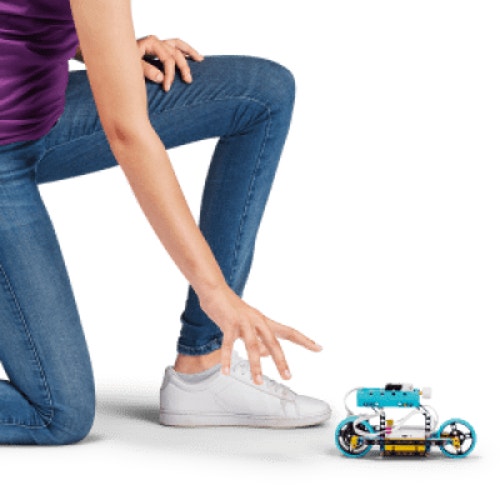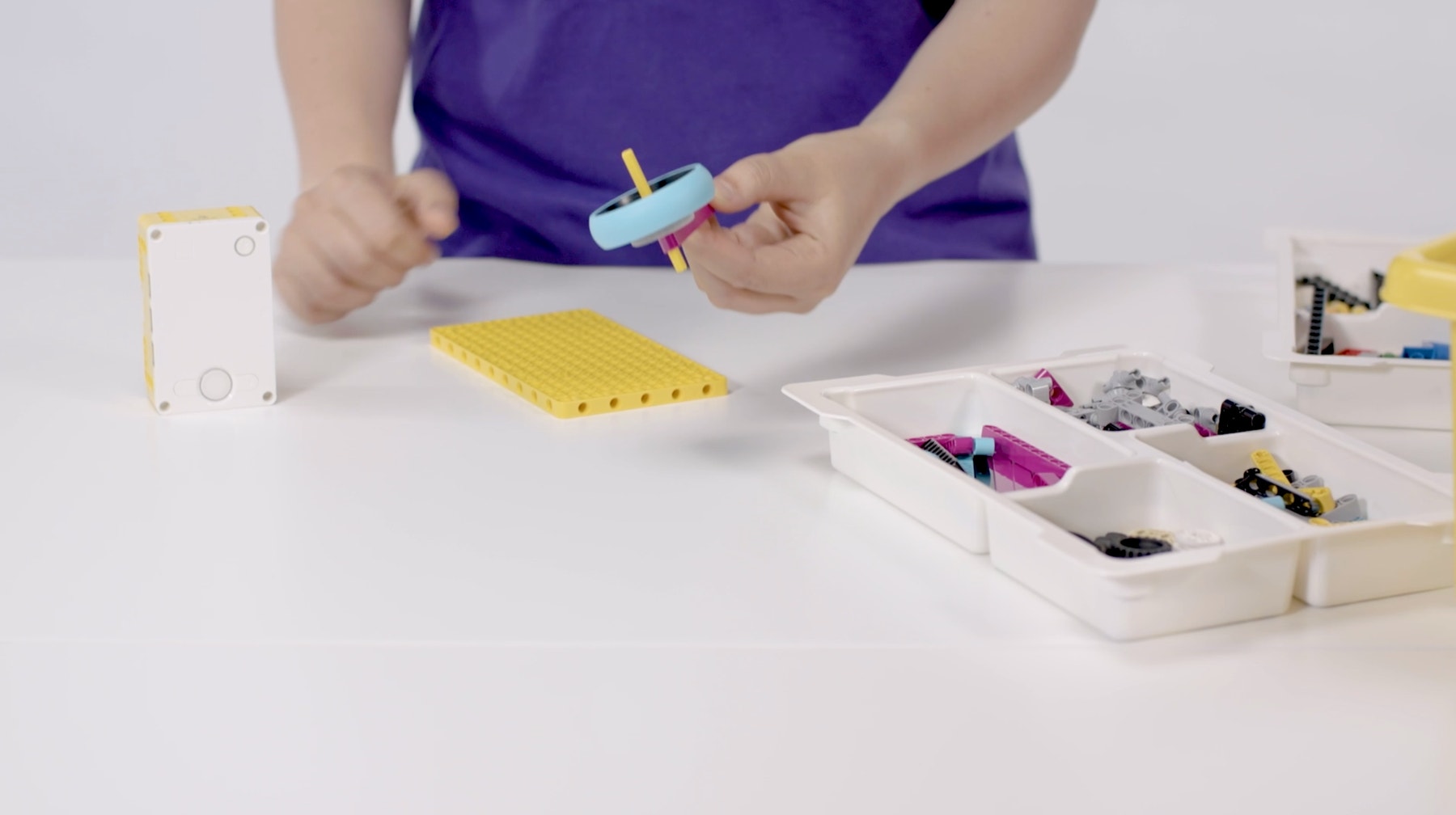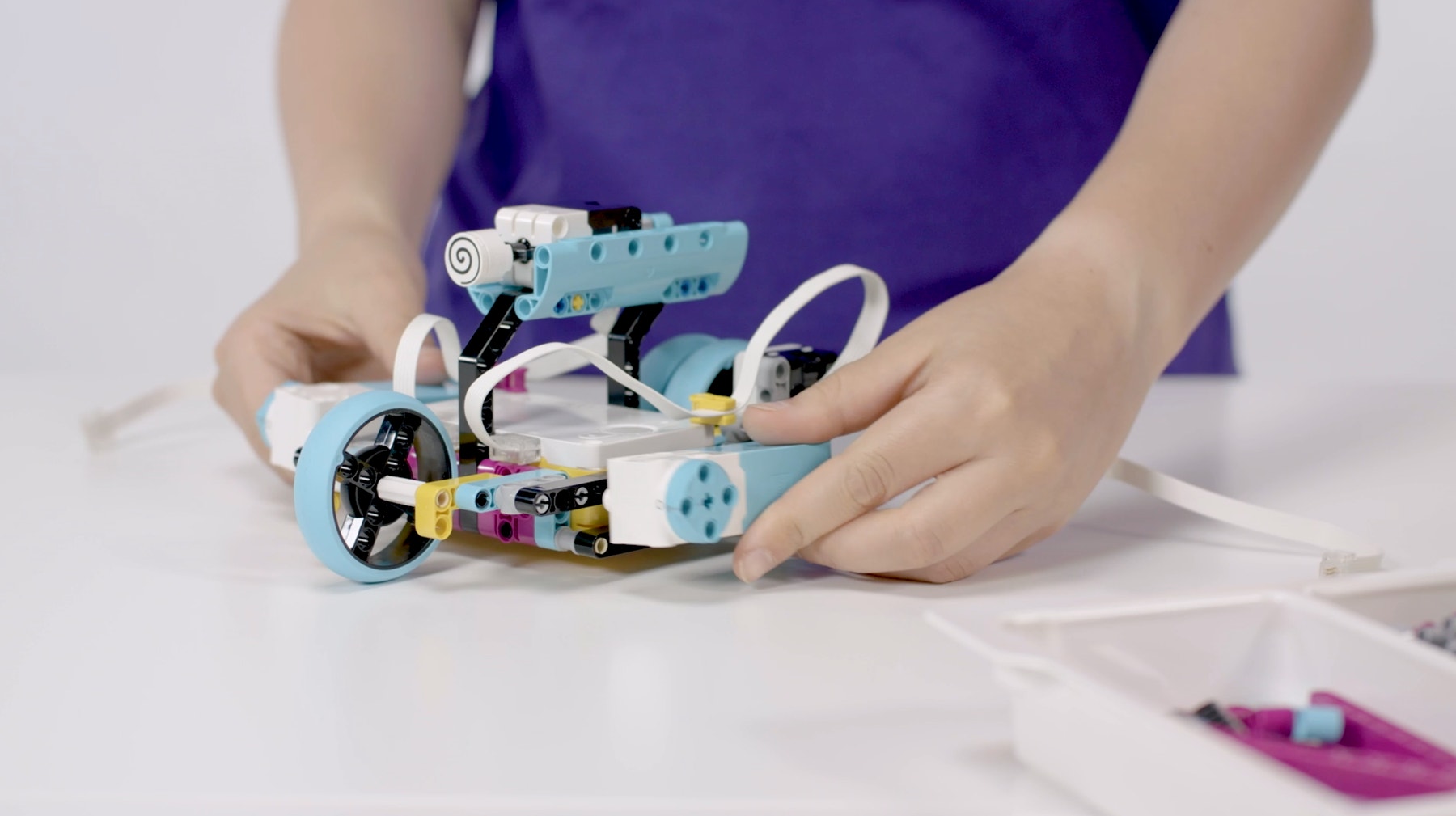Aim for It
Use variable speed to explore kinetic energy during a movement.

Engage
(Before Class, 20 Min.)
- This lesson explores how kinetic energy relates to speed and mass. Your students will perform an experiment focusing on measuring the distance that’s been travelled over time. They’ll use wheel rotation as input. Using a graph that shows a wheel’s rotations over time, they'll trace a graph showing the distance that’s been travelled over a period of time, and then try to graph the speed over time. Finally, they'll use the maximum speed value to calculate the kinetic energy using this formula: Ek = ½mv2 m = 305 g
- Use various materials to engage your students on the topic of kinetic energy.
Ignite a Discussion
Start a discussion by asking questions related to the lesson. Here are a few suggestions:
- What does the graph showing the distance that was travelled over time look like?
- What does the graph showing the speed over time look like?
- What does the graph showing the kinetic energy over time look like?
Have your students write down their thoughts as a hypothesis.
Explore
(During the Lesson, 30 Min.)
- Have your students build a vehicle with free-moving wheels. It must also be able to count wheel rotations. They can create their own models or follow the building instructions in the app to build the Street Curling Rock model.
- Ask your students to try out their models using the suggested program.
- Have them trace a graph of the distance that’s been travelled over time, and describe what they see:
- What do the spikes in the graph represent?
- Why does the space between the spikes increase as time goes by?
Explain
(During the Lesson, 15 Min.)
- Have your students continue the experiment by:
- Converting the rotations per seconds into distance
- Converting the distance that’s been travelled over time into speed
- Allow your students some time to adjust their programs to improve their performance.
- Encourage them to record as much data as possible during their experiments.
- Have them export their data as a CSV file so that they can manipulate it using other software if they wish.
Elaborate
(After the Lesson, 20 Min.)
- If your students still have access to their SPIKE Prime Sets, have them complete the tasks given in the SPIKE App. This will help them to elaborate on their learning with a bit of hands-on activity. Here are some examples:
- Have your students play a game while logging the performance of their throws. Tell them to push their street curling rocks, attempting to have the front of the model stop as close to the centre of the target as is possible. Explain that each student or team has 3 goes. They must measure the distance the centre of the target to the front of their model after each attempt. The student or team with the smallest cumulative distance after 3 goes wins the game!
- If your students don't have access to their sets, have them complete their Inventor Notebooks, or assign one of the extension activities that’s been suggested below. Most of the extension activities can be done using the data that was collected during the hands-on session
- Facilitate a sharing session in which your students exchange information. This can be done using whichever method/tool is the most efficient (i.e. in-person or online).
Evaluate
- Give feedback on each student's performance.
- To simplify the process, you can use the assessment rubrics that have been provided.
Assessment Opportunities
Teacher Observation Checklist
Establish a scale that suits your needs, for example:
Partially accomplished
Fully accomplished
Overachieved
Use the following success criteria to evaluate your students' progress:
- The students are able to program a device that logs data on a line graph.
- The students are able to interpret the values coming from the line graph.
- The students can explain kinetic energy in relation to speed.
Self-Assessment
Have each student choose the brick that they feel best represents their performance.
- Blue: I’m able to graph data using the program that’s been provided in the app.
- Yellow: I’m able to create my own line graph and explain my results.
- Violet: I've created new experiments on my own.
Peer Feedback
Encourage your students to provide feedback to one another by:
Having one student use the coloured brick scale above to score another student’s performance.
Asking them to present constructive feedback to one another so that they can improve their group’s performance during the next lesson. This is an excellent opportunity to use videoconferencing tools or blog posting tools in a blended learning scenario.

Differentiation
Simplify this lesson by:
- Limiting the lesson's focus to variations in the distance that’s been travelled over time
Take this lesson to the next level by:
- Asking your students to design and build their own freewheeling vehicles and curling rocks, repeat the experiment and compare their data to another model’s performance (e.g. a classmate’s model)
- Having your students design and build their own pushing devices that can provide more regular throws, and document the design process

Tips
Building Tips

Coding Tips
This lesson is designed to be played while the hub is connected through USB or Bluetooth. While connected, the data collected by the Hub is streamed directly to your device, and traced in real-time on the Line Graph.
Main Program

Solution Program

Science Data Tips
Here’s an example of the data your students can expect from this experiment.

Extensions
Maths Extension
To incorporate the development of maths skills:
- Have your students explore what happens when they change their curling rock's mass by adding elements (e.g. motors) or a heavy object (e.g. a water bottle). Ask them to update their models, rerun the experiment and compare the graphs showing the speed over time for the different masses.
Note: This will require additional time.

Literacy Extension
To incorporate the development of literacy skills:
- Ask your students to create a marketing campaign promoting the key features of their models. Tell them to include the model's technical characteristics and use scientific facts related to the concepts of speed and energy to highlight their benefits.
Note: This will require additional time.

Career Links
The students who enjoyed this lesson might be interested in exploring these career pathways:
- Education & Training
- Health Science
Teacher Support
Students will:
- Calculate the initial speed for a decelerating movement from a graph showing the distance that’s been travelled over time
- Use this approximated speed to calculate the average kinetic energy
LEGO® Education SPIKE™ Prime Set
Device with the LEGO Education SPIKE App installed
ACSIS125
Collaboratively and individually plan and conduct a range of investigation types, including fieldwork and experiments, ensuring safety and ethical guidelines are followed.
ACSSU155
Energy appears in different forms, including movement (kinetic energy), heat and potential energy, and energy transformations and transfers cause change within systems.
ACMNA208
Solve problems involving direct proportion. Explore the relationship between graphs and equations corresponding to simple rate problems.
ACMNA193
Plot linear relationships on the Cartesian plane with and without the use of digital Technologies.
ACMNA194
Solve linear equations using algebraic and graphical techniques. Verify solutions by substitution.
ACMNA178
Given coordinates, plot points on the Cartesian plane, and find coordinates for a given point.
ACELY1725
Plan, draft and publish imaginative, informative, and persuasive texts, selecting aspects of subject matter and particular language, visual, and audio features to convey information and ideas.
ACELY1810
Experiment with text structures and language features to refine and clarify ideas to improve the effectiveness of students’ own texts.
ACTDIP017
Define problems in terms of data and functional requirements drawing on previously solved problems.
ACTDIP029
Design algorithms represented diagrammatically and in English, and trace algorithms to predict output for a given input and to identify errors.
ACTDEK034
Analyse ways to produce designed solutions through selecting and combining characteristics and properties of materials, systems, components, tools, and equipment.